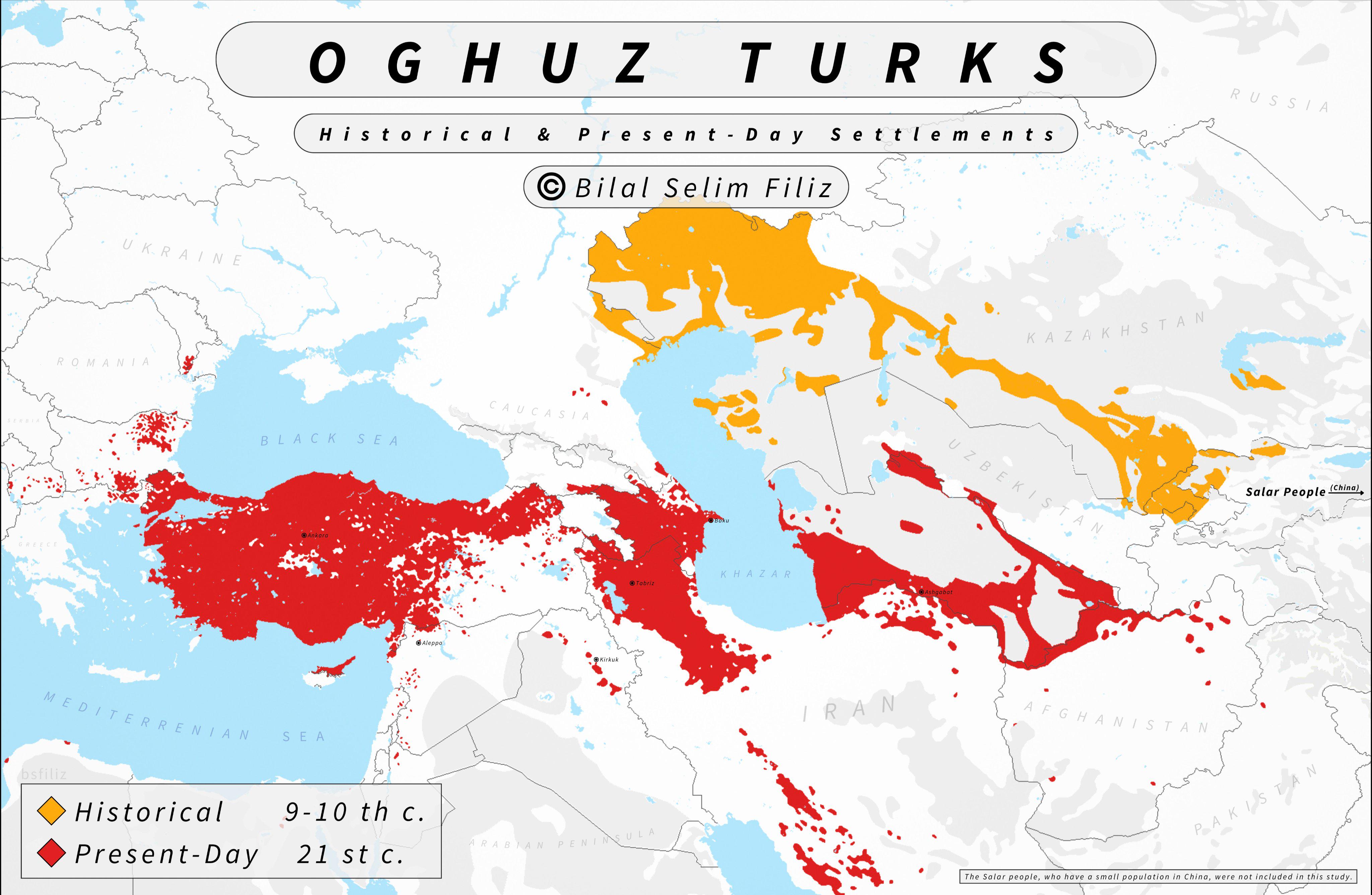Oghuz Turks Historical and Present Day Settlements Map


David Chen
Data Visualization Specialist
David Chen is an expert in transforming complex geographic datasets into compelling visual narratives. He combines his background in computer science ...
Geographic Analysis
What This Map Shows
The "Oghuz Turks Historical and Present Day Settlements Map" provides a comprehensive overview of the regions historically inhabited by the Oghuz Turks, as well as their current settlements across various countries. This map not only highlights the geographical distribution of the Oghuz Turks but also serves as a window into the cultural and historical dynamics that have shaped their presence in these areas. From their origins in the Central Asian steppes to their contemporary populations in Turkey, Azerbaijan, and beyond, this map encapsulates a rich tapestry of migration and settlement patterns.
Deep Dive into Oghuz Turks
The Oghuz Turks are a significant group within the larger Turkic peoples, emerging in the 6th century CE. Historically, they were nomadic tribes that roamed the vast steppes of Central Asia, particularly in what is now modern-day Turkmenistan and Kazakhstan. What's fascinating is that their name, "Oghuz," is believed to derive from a word meaning "tribe" or "clan," illustrating their strong communal ties.
As the Oghuz Turks migrated westward over the centuries, they established various states and empires, most notably the Seljuk Empire in the 11th century. This empire played a crucial role in the spread of Islam and the Turkish language into the regions of Anatolia, Persia, and the Middle East. The Oghuz Turks' influence can still be seen in the cultural and linguistic landscapes of these areas today.
Today, the Oghuz Turks primarily inhabit Turkey, Azerbaijan, and parts of Iran, Turkmenistan, and Iraq. In Turkey alone, they constitute a large part of the population, particularly in central and eastern regions. The Oghuz dialects of Turkish, such as Anatolian Turkish, are spoken by millions, highlighting the enduring legacy of their migration.
Interestingly, the Oghuz Turks are known for their rich tradition of oral literature and epic poetry, which have been passed down through generations. Their folklore, often centered around themes of heroism and adventure, has played a significant role in shaping Turkish national identity.
In terms of demographics, the map indicates not only where Oghuz Turks are concentrated but also their interactions with other ethnic groups. For instance, in Azerbaijan, the Oghuz heritage is intertwined with that of Persians and other local populations, creating a diverse cultural milieu.
Regional Analysis
Examining the geographical distribution of the Oghuz Turks reveals intriguing regional variations. In Turkey, for example, the largest concentrations can be found in the provinces of Anatolia, where they have historically settled and integrated with other Turkish tribes. Cities like Kayseri and Konya are often regarded as cultural centers for Oghuz traditions.
On the other hand, in Azerbaijan, the Oghuz Turks have a unique identity that blends with the local Azerbaijani culture. This is evident in their music, dance, and culinary traditions, which have evolved over centuries. The historical connections between the Oghuz Turks and the Azerbaijani people are often reflected in the shared use of the Turkic language.
In Turkmenistan, the Oghuz legacy is particularly prominent, as the country's name itself derives from the Oghuz tribes. The Turkmen people, who are direct descendants of the Oghuz Turks, have maintained their nomadic heritage even in modern times, often moving between traditional encampments and urban settings.
Significance and Impact
Understanding the historical and present-day settlements of the Oghuz Turks is crucial, not just from a geographical perspective but also in terms of cultural studies. The Oghuz Turks have played a pivotal role in the formation of modern nation-states in the regions they inhabit. Their migration patterns have influenced demographic changes, cultural exchanges, and even political landscapes.
In today's global context, the Oghuz Turks are part of a larger narrative regarding ethnic identity and nationalism. With the rise of globalization, many Oghuz Turks are navigating the delicate balance between preserving their rich cultural heritage and adapting to contemporary societal changes. Have you noticed how the younger generations are increasingly engaging with their roots through music and art?
As we look to the future, the legacy of the Oghuz Turks continues to evolve. The ongoing dialogues around cultural preservation, migration, and identity are pertinent not only to the Oghuz but also to many ethnic groups around the world. The map serves as an important reminder of how historical migrations shape the present and future of cultures globally.
Visualization Details
- Published
- September 10, 2025
- Views
- 96
Comments
Loading comments...